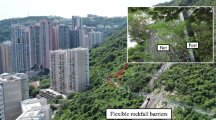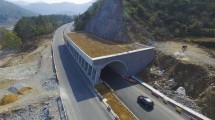Abstract
A field investigation on the actual protective performance of a flexible rockfall barrier along a mountain road in western China is presented in this paper. The total area of the flexible rockfall barrier under investigation was approximately 20,000 m2. Five typical failure modes of the flexible rockfall barrier were revealed, including steel post buckling, connection failure, ring net destruction, steel cable rope breakage and anchorage point failure. In addition, component rusting, which leads to decrease in durability, was noted. Furthermore, failure mechanisms were analysed, and the main factors that were found to induce flexible rockfall barrier failure included the sliding capacity of the cable ropes at the end post support positions, the boundary conditions of the steel posts and the compatibility between the energy dissipating devices and connected cable ropes. From these observations, corresponding design strategies were proposed. In addition, an improved flexible rockfall barrier system was constructed, and its effectiveness was verified by a full-scale impact test using 5000 kJ of impact energy. Finally, the impact deflection, impact force, cable force and energy dissipation of the improved flexible rockfall barrier system were studied in combination with a non-linear numerical simulation which could be a useful tool for design of flexible barrier systems.
















Similar content being viewed by others
References
Albaba A, Lambert S, Kneib F, Chareyre B, Nicot F (2017) DEM modeling of a flexible barrier impacted by a dry granular flow. Rock Mech Rock Eng 50:3029–3048. https://doi.org/10.1007/s00603-017-1286-z
Bertolo P, Oggeri C, Peila D (2009) Full-scale testing of draped nets for rock fall protection. Can Geotech J 46:306–317
Buzzi O, Leonarduzzi E, Krummenacher B, Volkwein A, Giacomini A (2015) Performance of high strength rock fall meshes: effect of block size and mesh geometry. Rock Mech Rock Eng 48:1221–1231. https://doi.org/10.1007/s00603-014-0640-7
Castanon-Jano L, Blanco-Fernandez E, Castro-Fresno D, Ballester-Muñoz F (2017) Energy dissipating devices in falling rock protection barriers. Rock Mech Rock Eng 50:603–619. https://doi.org/10.1007/s00603-016-1130-x
Castro-Fresno D, del Coz Diaz JJ, López LA, Nieto PJG (2008) Evaluation of the resistant capacity of cable nets using the finite element method and experimental validation. Eng Geol 100:1–10. https://doi.org/10.1016/j.enggeo.2008.02.007
Cazzani A, Mongiovı L, Frenez T (2002) Dynamic finite element analysis of interceptive devices for falling rocks[J]. Int J Rock Mech Min Sci 39(3):303–321
Coulibaly JB, Chanut MA, Lambert S, Nicot F (2017) Non-linear discrete mechanical model of steel rings. J Eng Mech, 143(9). https://doi.org/10.1061/(ASCE)EM.1943-7889.0001303
Descoeudres, F., Stoffel, S. M., Boll A, et al (1999) Chapter 4, Rockfalls, in: Coping study on disaster resilient infrastructure, commissioned by the secretariat for the international decade for natural disaster reduction for the IDNDR programme forum “Parterships for a safer world in the 21st century”, edited by: Minor, H.-E., United Nations, 37–46
Dhakal S, Bhandary NP, Yatabe R, Kinoshita N (2011) Experimental, numerical and analytical modelling of a newly developed rockfall protective cable-net structure. Nat Hazards Earth Syst Sci 11:3197–3212
Dhakal S, Bhandary NP, Yatabe R, Kinoshita N (2012) Numerical and analytical investigation towards performance enhancement of a newly developed rockfall protective cable-net structure. Nat Hazards Earth Syst Sci 12:1135–1149
Escallón J.P., Wendeler C (2013) Numerical simulation of quasi-static and rockfall impact tests of ultra-high strength steel wire-ring nets using Abaqus/Explicit. In: SIMULIA Community Conference. Vienna,Austria
Escallón JP, Wendeler C, Chatzi E, Bartelt P (2014) Parameter identification of rockfall protection barrier components through an inverse formulation. Eng Struct 77:1–16. https://doi.org/10.1016/j.engstruct.2014.07.019
Escallón JP, Boetticher V, Wendeler C et al (2015) Mechanics of chain-link wire nets with loose connections. Eng Struct 101:68–87
ETAG 027 (2013) Guideline for European technical approval of falling rock protection kits. 06, 2013
GB 50017 (2017) Standard for design of steel structures. MOHURD & AQSIQ, Beijing, China
Gentilini C, Govoni L, de Miranda S, Gottardi G, Ubertini F (2012) Three-dimensional numerical modelling of falling rock protection barriers. Comput Geotech 44:58–72. https://doi.org/10.1016/j.compgeo.2012.03.011
Gentilini C, Gottardi G, Govoni L, Mentani A, Ubertini F (2013) Design of falling rock protection barriers using numerical models. Eng Struct 50(3):96–106
Geobrugg (2016) Product manual RXE-8000 rockfall barrier,Switzerland
Gerber W, Boell A (2006) Type-testing of rockfall barriers—comparative results. In: International Proceedings of the INTERPRAEVENT Congress. Nigata, 189–198
Gottardi G, Govoni L (2010) Full-scale modelling of falling rock protection barriers. Rock Mech Rock Eng 43:261–274. https://doi.org/10.1007/s00603-009-0046-0
Grassl H, Volkwein A, Anderheggen E, Ammann WJ (2002) Steel-net rockfall protection-experimental and numerical simulation. Seventh Int Conf Struct Under Shock Impact Montr Canada 143–153
Grassl H, Volkwein A, Bartelt P (2003) Experimental and numerical modeling of highly flexible rockfall protection barriers. Proc Soil Rock Am 2003 , Cambridge, Massachusetts
Hoek E (2007) Practical rock engineering Available online: http://www.rocscience.com/
JT/T 528 (2004) Component of flexible system for protecting highway slope,07,2004
Kwan JSH, Chan SL, Cheuk JCY, Koo RCH (2014) A case study on an open hillside landslide impacting on a flexible rockfall barrier at Jordan Valley, Hong Kong. Landslides 11:1037–1050. https://doi.org/10.1007/s10346-013-0461-x
LS-Dyna theory manual (2006) Livermore Software Technology, California
Luciani A, Barbero M, Martinelli D, Peila D (2016) Maintenance and risk management of rockfall protection net fences through numerical study of deteriorations. Nat Hazards Earth Syst Sci 1–12
Masuya H, Amanuma K, Nishikawa Y, Tsuji T (2009) Basic rockfall simulation with consideration of vegetation and application to protection measure. Nat Hazards Earth Syst Sci 9:1835–1843. https://doi.org/10.5194/nhess-9-1835-2009
Mentani A, Giacomini A, Buzzi O, Govoni L, Gottardi G, Fityus S (2016) Numerical modelling of a low-energy rockfall barrier: new insight into the bullet effect. Rock Mech Rock Eng 49(4):1247–1262
Moon T, Oh J, Mun B (2014) Practical design of rockfall catchfence at urban area from a numerical analysis approach. Eng Geol 172:41–56. https://doi.org/10.1016/j.enggeo.2014.01.004
Morton EC, Thompson a G, Villaescusa E, Roth A (2007) Testing and analysis of steel wire mesh for mining applications of rock surface support. 1061–1064
Peila D, Ronco C (2009) Technical note: design of rockfall net fences and the new ETAG 027 European guideline. Nat Hazards Earth Syst Sci 9:1291–1298
Peila D, Pelizza S, Sassudelli F (1998) Evaluation of behaviour of rockfall restraining nets by full scale tests. Rock Mech Rock Eng 31:1–24. https://doi.org/10.1007/s006030050006
Qi X(2013) Mechanics performance of passive flexible protection structure. Dissertation, Southwest Jiaotong University.(In Chinese)
Qi X, Yu ZX, Xu H et al (2017a) Research on cumulative impact resistance of passive flexible protective structure. Chin J Rock Mech Eng 36: 2788–2797 (In Chinese)
Qi X, Xu H, Yu ZX et al (2017b) Dynamic mechanical properties study of the break rings in flexible protective system. Eng Mech 35(9): https://doi.org/10.6052/j.issn.1000-4750.2017.06.0438(In Chinese)
Rocscience (2018). https://www.rocscience.com/rocscience/products/rocfall/applications/rockfalls
Tran PV, Maegawa K, Fukada S (2013) Prototype of a wire-rope rockfall protective fence developed with three-dimensional numerical modeling[J]. Comput Geotech 54(10):84–93
Vogel T, Labiouse V, Masuya H (2009) Rockfall protection as an integral task. Struct Eng Int 19:304–312
Volkwein, A. (2004) Numerische Simulation von flexiblen Stein-schlagschutzsystemen, Ph.D. thesis, Eidgenossische Technische Hochschule Zürich
Volkwein A (2005) Numerical simulation of flexible rockfall protection systems. Proc. Computing in civil engineering. Cancun, Mexico, 1–11
Volkwein A, Roth A, Gerber W, Vogel A (2009) Flexible rockfall barriers subjected to extreme loads. Struct Eng Int 19:327–331
Volkwein A, Schellenberg K, Labiouse V, Agliardi F, Berger F, Bourrier F, Dorren LKA, Gerber W, Jaboyedoff M (2011) Rockfall characterisation and structural protection—a review. Nat Hazards Earth Syst Sci 11:2617–2651
Von Boetticher A , Volkwein A, Wendeler C (2010) Numerical modelling of new rockfall interception nets. In: Egu General Assembly Conference. p 15641
Von Boetticher A, Volkwein A (2018) Numerical modelling of chain-link steel wire nets with discrete elements. Canadian Geotechnical Journal 43:cgj-2017-0540.
Wang S. (2015) Study on the mechanical properties of the circular net structure in the flexible interception protection. Dissertation, Southwest Jiaotong University. (In Chinese)
Wang M, Shi SQ, Yang YK (2011) Static tensile test and FEM dynamic simulation for a ring-brake energy disspater. J Vib Shock 30(4):188–193 (In Chinese)
Wriggers P (2007). Computational contact mechanics. Computational Contact Mechanics Springer Vienna 141
Xcitex (2017). https://www.xcitex.com/proanalyst-motion-analysis-software.php
Xu H, Gentilini G, Yu ZX et al (2018) An energy allocation based design approach for flexible rockfall protection barriers[J]. Eng Struct 173:831–852
Yu ZX, Qiao YK, Zhao L et al (2018a) A simple analytical method for evaluation of flexible rockfall barrier part 1: working mechanism and analytical solution. Adv Steel Constr 14(2):115–141. https://doi.org/10.18057/IJASC.2018.14.2.1
Yu ZX, Qiao YK, Zhao L et al (2018b) A simple analytical method for evaluation of flexible rockfall barrier part 2: application and full-scale test. Adv Steel Constr 14(2):142–165. https://doi.org/10.18057/IJASC.2018.14.2.2
Zhao SC, Yu ZX, Wei T et al (2013) Test study of force mechanism and numerical calculation of safety netting system. Chin Civil Eng J J46(5):122–128. https://doi.org/10.15951/j.tmgcxb.2013.05.009 (In Chinese)
Zhao SC, Yu ZX, Zhao L et al (2016) Damage Mechanism of Rockfall Barriers Under Strong Impact Loading. Eng Mech 33(10):24–34. https://doi.org/10.6052/j.issn.1000-4750.2016.06.ST08 (In Chinese)
Funding
The work of this study was supported by the National Natural Science Foundation of China under grant No. 51678504 and No. 51408498, the Department of Science and Technology of Sichuan Province under Grant No. 2018JY0029, the Open Fund of National Engineering Laboratory for Bridge Structure Safety Technology under grant No. 310821151102 and the Fund of State Key Laboratory of Geohazard Prevention and Geoenvironment Protection under grant No. SKLGP2016K013. This study was also financially supported by the Innovation and Technology Fund of the Hong Kong SAR Government for the project “Development of an energy absorbing device for flexible rock-fall barriers (ITS/059/16FP)”.
Author information
Authors and Affiliations
Corresponding author
Rights and permissions
About this article
Cite this article
Yu, Z.X., Zhao, L., Liu, Y.P. et al. Studies on flexible rockfall barriers for failure modes, mechanisms and design strategies: a case study of Western China. Landslides 16, 347–362 (2019). https://doi.org/10.1007/s10346-018-1093-y
Received:
Accepted:
Published:
Issue Date:
DOI: https://doi.org/10.1007/s10346-018-1093-y




